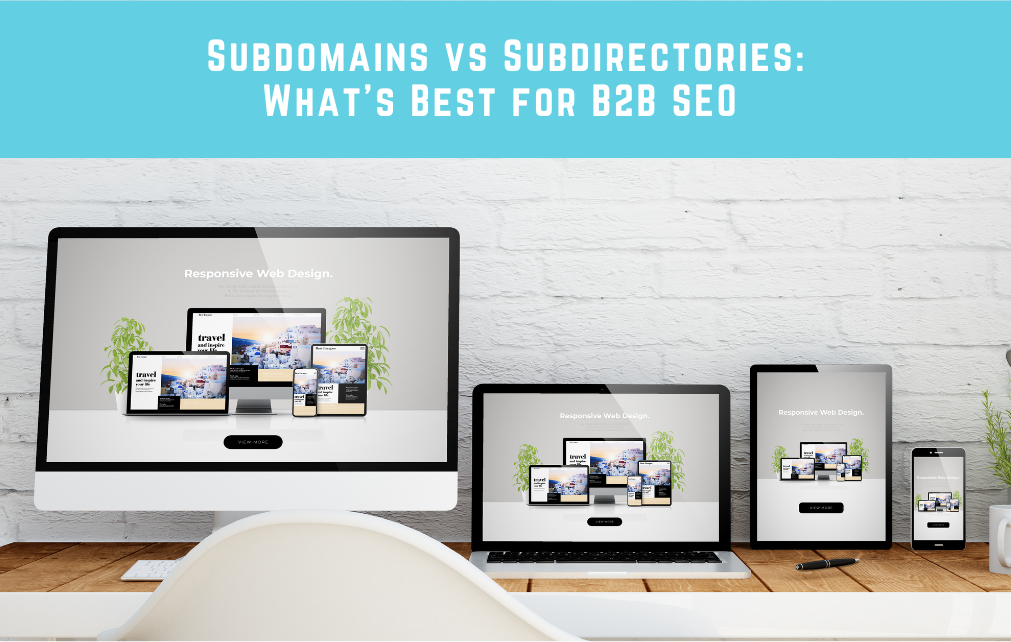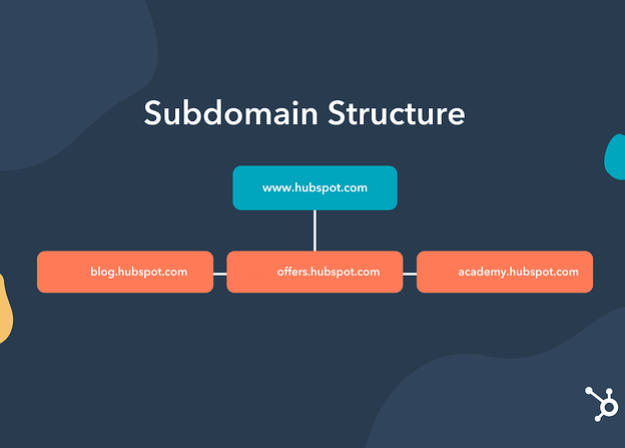
One of the longest-running debates in SEO is the use of “subdomains or subdirectories" for website content such as blogs, landing pages, and resource libraries. For B2B businesses, making the right choice can significantly impact your site's SEO performance and user experience. Not to worry; we've got your answer right here.
What is a primary domain name vs. a subdomain?
A primary domain name for a website and a URL literally map the website name to an IP address where the website is hosted. For example, these are primary domains: orangemarketing.com, google.com, cnn.com, and so on. A subdomain means "a subdivision of a domain."
A subdomain is a small word or phrase on the front of the primary domain. For example, when you migrate your blog to HubSpot, we will frequently recommend moving the blog to blog.orangemarketing.com. We like to use "go." or "info." as the subdomain for landing pages. Fun fact: even in the case of www.orangemarketing.com the "www" is a subdomain.
 From HubSpot
From HubSpot
Backstory: The history of the subdomain SEO debate
In the 2000s, when Google was less sophisticated, conventional SEO wisdom held that subdirectories (e.g., example.com/blog) were the way to go instead of subdomains (e.g., blog.example.com) and that your primary domain wouldn’t get any SEO credit for rankings earned by a subdomain. This means Google treated a subdomain 100% separately from a domain in website rankings. In 2011, Google substantially changed its search algorithm to acknowledge subdomains as part of domains, but the debate persists.
First, look at how Google changed what subdomains mean for SEO, what exactly subdirectories and subdomains are, and what it means for your site if you want to move from one to the other.
The Importance of B2B SEO
For B2B businesses, effective SEO strategies are crucial for reaching and engaging with target audiences. Unlike B2C, which focuses on broad consumer appeal, B2B SEO requires a more targeted approach to connect with specific business segments and decision-makers. Implementing the right SEO practices, including the strategic use of subdomains, can significantly enhance visibility, drive high-quality traffic, and ultimately generate more qualified leads. By optimizing your site structure and content for B2B SEO, you can improve your search engine rankings and ensure that your business stands out in a competitive marketplace.
Subdirectories
This website hierarchy has a root domain that uses subdirectories—also called subfolders—to organize your website content. Each subdirectory can build off of one another (almost indefinitely). This hierarchy can be great for B2B SEO because it keeps any earned backlinks, domain authority, and page authority closely tied to the root domain. But beware: too many layers can create an SEO nightmare for both search engine spiders and your site visitors.

Subdomains
This type of website hierarchy is also under a root directory; however, instead of using folders to organize your website content, it's kind of like a website of its own. That's because it will usually have a separate content management system, templates, etc.—all while still being closely tied to the root directory or main domain. All subdomains are on the same level rather than being one within another, like with subdirectories. However, each subdomain can have its own subdirectories if it makes sense for content organization.

When to use a subdomain
A single-subdomain approach will be more than enough for smaller sites (less than 20 pages). Separating different types of content will benefit more complex sites and any website with a content strategy.
Subdomains can provide organization and structure to your site if you have a lot of different—but important—content to share. They're also ideal if your business houses content that would be difficult to manage on one website. For B2B businesses, this can be particularly useful. You might have separate subdomains for different product lines, customer support, or regional offices.
Subdomains also benefit B2B businesses looking to create a robust online presence. They allow you to segment your content effectively, making it easier for your target audience to find what they want. For instance, you could have blog.yourdomain.com for industry insights, resources.yourdomain.com for whitepapers and case studies, and support.yourdomain.com for customer support.
According to HubSpot community consensus, the SEO pros of moving to a subdomain outweigh the possible (mostly unknown and theoretical) cons. In this day and age, we don't believe any cons exist. However, SEO know-it-alls and ancient web tech guys will die on the hill that subdomains hurt your website's ranking. Come on. Is Google actually that stupid? Nope. And we do not see evidence of any "hurt."
We frequently point the skeptics to this well-known 2017 video from Google Webmasters Trends Analyst John Mueller.
The takeaway
The bottom line is this: Google is smart enough to understand that blog.yourdomain.com is part of yourdomain.com. It will not hurt SEO and is not an immediate concern unless there are other issues such as duplicate content, poor metadata, bad URLs, and all the other SEO 101 items that should be top of your tidy-up list.
For B2B businesses, using subdomains can significantly enhance your site's organization and user experience. Therefore, unless you’re already planning on reorganizing your website, there’s no SEO-specific reason for undertaking a project to remove subdomains and move entirely to a subfolder structure. Embrace subdomains to create a well-structured, easy-to-navigate website that meets the needs of your diverse audience segments.
